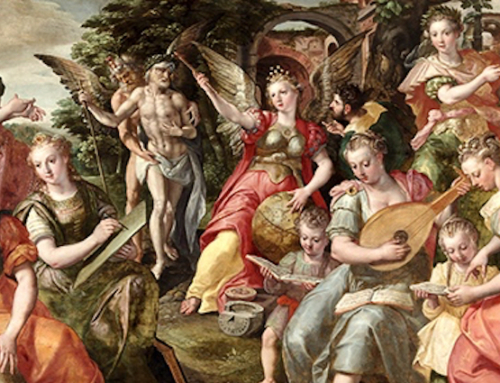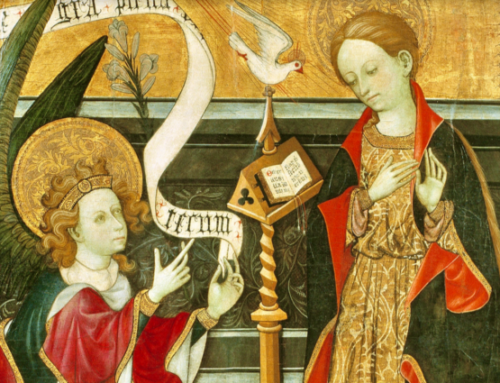Words are only one level at which we can understand the world. Franz Liszt used sounds, melodies, and changes to convey the religious experience of Alphonse de Lamartine’s poem “Apparitions.” That is the joy of listening to classical music: It is an exercise in understanding the mind of a genius on a deeper level, one that works solely through emotion and in the process exposes our own emotions unto us.
 Classical music speaks to us in a way that lyrical music can often obscure. The nature of speech and language, and the effects they have on our minds, imparts a message or describes an environment to which instrumental music becomes subordinate, or at least supplementary. Music in an age of the “self”—of self-absorption, self-aggrandizement, and self-prioritization—makes the verbal medium more necessary in order to express in words how we relate the world to ourselves and others. One might even say that it is the only possible way that art is conveyed today; that is, through verbal explanation where the audience is told how to feel about a particular piece, and explained why. Art, arguably, should not need such facilitation.
Classical music speaks to us in a way that lyrical music can often obscure. The nature of speech and language, and the effects they have on our minds, imparts a message or describes an environment to which instrumental music becomes subordinate, or at least supplementary. Music in an age of the “self”—of self-absorption, self-aggrandizement, and self-prioritization—makes the verbal medium more necessary in order to express in words how we relate the world to ourselves and others. One might even say that it is the only possible way that art is conveyed today; that is, through verbal explanation where the audience is told how to feel about a particular piece, and explained why. Art, arguably, should not need such facilitation.
Words are only one level at which we can understand the world. And language is, frankly, an empty medium if not interpreted through an initial, alternate sense. Art, for this reason, we say is felt. Music is no exception to this concept. If what we seek in music, or any other form of expression, is self-validation, then language and explicitness are the only options. If what we seek in music, however, is aesthetic challenge in the form of musical art, then classical music can never be dismissed from our libraries. Classical music requires two things that are, perhaps, uncomfortable for us modern men and women: extended patience and long-spanning attention. Not to mention that classical music (superficially) deprives us of the sense on which we so heavily rely today—the visual—and removes the simplest layer of our auditory sense—language—that directly tells us how to feel or think about a certain topic. Instead, it leaves us without direct visuals and without direct audition. This absence of explicit sense exposure and explanation is, I believe, what creates good art, be it visual, musical, or literary.
This previous statement relates to music in that sound speaks differently to our senses and reaches, thus, another level of our consciousness, especially when we make the effort to listen to classical music, be it older or contemporary—both are a challenge well worth undertaking. We often think classical music means attuning our ears to Beethoven and Mozart, and of course these are composers where one can begin. From them, we might discover our own preferences. After beginning with Mozart, Beethoven, and Bach, I found the musicians that really opened and lengthened my conceptual and auditory attention span, and whose music spoke to me the most: Pyotr Tchaikovsky, Claude Debussy, Eric Satie, Frédéric Chopin, and Franz Liszt. The rest of this essay will focus on Liszt.
If classical music may superficially deprive us of our visual sense and force us only to listen, Liszt’s pieces, namely his Apparitions, reveal what lies beneath a veil of commonplace images. One can almost see the movement of his melodies; like many composers, he creates art in our minds that we only begin to see after a close listen. The history and influences behind Liszt’s Apparitions are, moreover, worth telling to further elaborate on the relationship between music and lyric and how they can work in harmony without sacrificing the transcendent element inherent in most art. Liszt composed Apparitions in 1834 at a young 22 years of age while living in France, and he published them along with a solo piano piece titled Harmonies poétiques et religieuses. A native of Hungary, he was fluent in French and hardly fluent in Hungarian—it was apparently common for distinguished Hungarians to speak other languages besides their own. He met Beethoven in 1822, which biographers describe as a pivotal moment in his career.
Beethoven had died just seven years earlier when Liszt composed his Apparitions. The work is comprised of three movements, all contrasting each other while maintaining idiosyncratic motifs that render it a challenging but rewarding listen, for they show how rapidly the European musical aesthetic was evolving in the wake of Beethoven.[1] The pieces are often described for their contradicting features, which has resulted in their characterization as being “avant-garde.” Such a label, however, should be taken with a grain of salt; the songs demonstrate influences from traditional Hungarian music and Wagner’s waltzes. Apparitions has unique elements that certainly make it an unusual piece, nonetheless. For example, it alternates moments of sound with moments of silence, and the playing directions that are written on the original score demand a formidable change and exchange of expression and emotion from the musician. Liszt features, moreover, constant tritones and uncommon harmonies and chromatic changes. The latter is attributed to Liszt’s interest in ancient Greek musical theory and the ideas of “musical speech.”[2]
The inspiration for Liszt’s Apparitions and the Harmonies is often attributed to the French poet and statesman, Alphonse Marie Louise de Lamartine, who wrote a poem of the same title “Apparition” in 1818 (published in 1820). Lamartine was an important figure in forming the Second French Republic, but he was also a writer with a keen interest in Orientalism. Lamartine, moreover, was a Catholic thinker who struggled with his faith throughout his life. Liszt, however, remained a devout Christian all his life. In his later years, Liszt chose to live a life closer to God, in solitude. He received the tonsure in 1865 and four minor orders in the Catholic Church as lector, porter, exorcist, and acolyte. His close relationship and participation in the Church led some people to refer to him as “Abbé Liszt.” Still, Liszt was strongly influenced by the philosophy of Lamartine. He was acquainted with Lamartine’s works, including his poetry and philosophical writings. They were also good friends and maintained contact throughout their lives.
Despite his evident and strong faith, most biographers of Liszt hardly mention the role of religion in his life. The connection between Liszt’s Catholic devotion and his musical composition is an area that merits more attention. Those interested in this topic might consider the book Revolution and Religion in the Music of Liszt, by Paul Merrick. The book provides necessary insight into the composer’s mind, and the historical context in which he wrote music. For example, where he composed the pieces, in Brittany, an important topic of the time was the need for separation of Church and State. Apart from this book, the lack of written content on this topic may yet be a saving grace for Liszt, since we must ascertain that religious conviction and spiritualism for ourselves by listening to his music, perhaps having a bit of it imparted on us.
The first piece is pacing and lyrical, while the second is faster and more dramatic. The final piece is titled “Fantasie sur une valse de François Schubert,” which describes itself as a meditation on, or “fantasy” about, a Schubertian waltz. A British classical label describes Liszt’s Apparitions thus: “The first piece has a rhythmic flexibility which often suspends the perceived metre altogether, and the theme in thirds with tremolo accompaniment is one of Liszt’s most compelling. The second is uneasily torn between being carefree and poignant, again the character led by the unusual rhythm, and the third is almost like a composer under some hallucinogenic drug, dreaming of a Schubert waltz—a unique contribution to the literature, and quite unlike the later use of the same waltz in the Soirées de Vienne” (listen to the pieces here).[3] The above description dismisses the religious elements and motifs at play throughout the pieces, which results in a curt description of the work.
Some say that the pieces in Apparitions are meant to convey a religious apparition that Liszt might have experienced in his life. Writing about these three works, Liszt explained, “I have tried to express in music some of my strongest feelings, my most vivid perception.” There are moments in the score where Liszt asks the composer to play with varied expressions such as “perdendosi” (losing oneself), “morendo” (dying, but not during the end of the piece, as the direction is commonly used), “quasi niente” (to almost nothing), “dolente” (sorrowful), “lamentoso” (lamentful), and “appassionato” (impassioned) in just a couple of measures. From looking at the way in which Liszt asks the musician to play Apparations (see full score here) one can understand that he is, truly, trying to convey and relay a particular feeling and perception.[4]
While the pieces are not meant to be a proper arrangement of sacred music or something one would hear in a church, they are personal and spiritual enough that they convey the effects of sacred music on the layman’s heart. The pieces are, to my ears, a rendition and rhapsody of sacred music adapted for the solo piano; that is, meant for personal sensation and interpretation, as though one was conversing with and feeling God’s presence in the confines of his or her own mind and trying to deal with the flux of emotions one would feel in such a moment. Even the titles of the pieces convey this complexity. The first piece, for example, is titled “senza lentezza quasi allegretto,” without slowness, almost bright: The pace is just in between contemplation and joy, and it explores the entirety of that realm—one emotion from many.
In the breaks between harmonies and melodies, Liszt inserts peculiar pauses. If the pieces as indeed the relaying of a religious experience, the pauses have a significant role as moments of change in thought. The use of silence throughout his pieces has been connected with Liszt’s fundamentally Christian view that death is not “extinction.” In his book, Merrick writes, “In Christianity, death is not extinction, and to have this nihilum [Latin for nothing] as the subject of sounding music – of a Christian composer’s musical meditation on the thoughts of a Christian poet (referring to Lamartine) – requires somehow its expression in relation to the language of music, or at least its notation. Liszt’s inspiration was to say that ‘music as nothing’ is ‘music without key.”[5] In this case, Merrick is referring to Liszt’s use of silence not only in Apparitions, but also in Harmonies Poétiques et Religieues.
Only so much can be written and said about these pieces, however. The beginning of this essay, after all, warns about the dangers of expressing music through mere language. Still, the religious element in Liszt’s composition needs to be emphasized so that a new listener might begin to understand to what he is listening. The element of the sacred in art, while palpably felt, needs also to be sustained through use and reuse. In a letter to a woman named Janka Wohl, Liszt wrote, “sacred music is scarcely cultivated at all, and it would take very little to make it die of inanition.” Perhaps Liszt would not have described Apparitions as sacred music, properly understood, but they certainly are a step for the modern reader towards sacred music. I find that both are necessary: the overall sacred and the internally sacred, and Liszt’s solo piano works (Apparitions and Harmonies) display the latter.
Finally, it is helpful to discuss the poem that Liszt used as a muse for his music. Lamartine’s poem that inspired Liszt’s Apparitions conveys this sense of personal sacredness and contemplation of death, and the varying emotions that would come from an “Apparition” signaling death. In the stanzas, the poet is speaking to an unclear entity:
Toi qui du jour mourant consoles la nature,
Parais, flambeau des nuits, lève-toi dans les cieux ;
Etends autour de moi, sur la pâle verdure,
Les douteuses clartés d’un jour mystérieux !
Tous les infortunés chérissent ta lumière ;
L’éclat brillant du jour repousse leurs douleurs :
Aux regards du soleil ils ferment leur paupière,
Et rouvrent devant toi leurs yeux noyés de pleurs. (1-8)
Lamartine calls to an entity who “on the day of death consoles nature” (1). The poet writes that this entity resembles the flame of the nights, and asks it to rise in the heavens and surround him so that he may cast on him, the poet, the doubtful lights of a mysterious day (2-4). It appears that the poet is dying, and that the entity is who he considers to be God. The poet continues to speak to the entity, saying that all the unfortunate cherish its light, which calms their pains (5-6). Upon seeing the sun they close their eyelids, reopening them before the entity, their eyes filled with tears (7-8).
The rest of the poem is worth reading for those with a good grasp of French. In the second stanza, the poet (perhaps Lamartine) continues to call to this apparition, asking it to guide him towards his grave. He is ready to die, but, as the apparition fades, he begins to see someone else—a woman. In the third stanza he speaks to her:
Est-ce bien toi ? toi qui t’inclines
Sur celui qui fut ton amant ?
Parle ; que tes lèvres divines
Prononcent un mot seulement.
Ce mot que murmurait ta bouche
Quand, planant sur ta sombre couche,
La mort interrompit ta voix.
Sa bouche commence… Ah ! j’achève :
Oui, c’est toi ! ce n’est point un rêve !
Anges du ciel, je la revois !… (19-28)
The poet is unsure if the woman is truly there, or simply a vision. He asks her “Is it really you? You who is inclined / over he who was once your lover?” (19-20). He asks her to speak (21), for death was interrupting her voice (25). As her mouth begins to move, he exclaims in joy—he really sees her; it is not a dream; he can see her again (27-28). The fourth stanza, the poet thanks God and his grace for sending her, the woman, and allowing him to see “that which my eyes always searched” (35). He then asks “What do you want? Must I die?” (36), and he gives in saying “Here, I will give you for this hour / all the hours of my days” (37-38). As the poet wavers in and out of death, he is thankful that God granted him the opportunity to see his love for one final hour.
In the fifth stanza, the poet questions for a moment his satisfaction with what he believes God has granted him. He questions how, after a “century of sorrows,” he would only be granted one word from the woman standing over him (40). He asks “Is that all?” but concludes “It is enough” (41) and decides to thank God for His mercy, since He “rarely pierces the sad obscurity” of death (45). The stanza concludes with the poet describing God’s light and beauty, perhaps as a way of signaling his final seconds alive. The poem itself reads like a conversation, and internal monologue with God, yet at the end we are left to wonder who the true apparition was: the woman, or God. Is the woman he sees still alive or already dead—a glimpse into what awaits him? An apparition, then, is not a ghost for Lamartine, but a vision of sorts that facilitates an experience of death and of peace with God, we might presume that this same message resonated with Liszt.
Apparitions shares elements of such a moment like what Lamartine describes in “Apparition”—exclamations, questions, hallucinations, sorrow, joy, frustration, lament—all without speech. Perhaps a good exercise to leave readers with would be to compare the emotions conveyed in Lamartine’s poem with Liszt’s pieces. While both are beautiful, there is definitely something unique about Liszt’s rendition of such a complex and spiritual subject. Would we use such sounds, melodies, changes, as Liszt to convey a religious experience? Even if not, that is the joy of listening to classical music: It is an exercise in understanding the mind of a genius on a deeper level, one that works solely through emotion and in the process exposes our own emotions unto us.
The Imaginative Conservative applies the principle of appreciation to the discussion of culture and politics—we approach dialogue with magnanimity rather than with mere civility. Will you help us remain a refreshing oasis in the increasingly contentious arena of modern discourse? Please consider donating now.
Notes:
[1] Description by Blair Johnson.
[2] Lisztomania, s.v. “Apparitions,” last modified February 8, 2011, 14:30.
[3] Listen to the pieces here.
[4] See the full score here.
[5] Lisztomania, s.v. “Apparitions.”
The featured image is “Apparition by Eugeniu Voinescu” and is licensed under the Creative Commons Attribution-Share Alike 4.0 International license., courtesy of Wikimedia Commons.







Leave A Comment